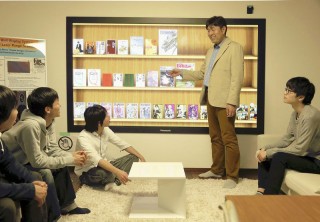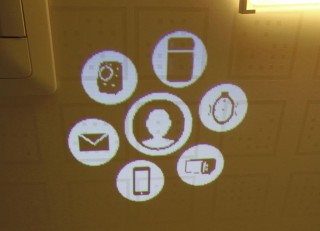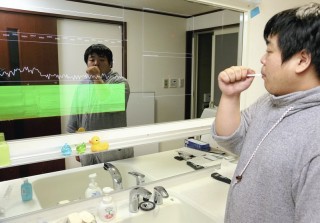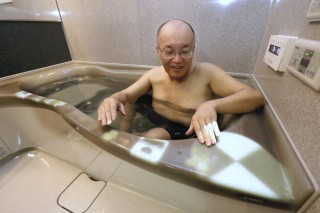Loading
Search
▼ A Smart Life in The Digital Era: IoT Technology Comes of Age in Experimental House of The future
- Category:Experience
KYOTO — These days, I have been getting more and more chances to experience the internet of things (IoT), which means internet-connected devices and objects that can be controlled remotely.
Recently I visited an experimental “smarthouse” at Kyoto Sangyo University in Kyoto that, using such technology, allows one to experience how homes might be in a decade.
The house is located on the third floor of the Faculty of Computer Science and Engineering building, and its layout is very similar to an ordinary apartment.
I went first to the living room. Opening the door, my eyes went immediately to a 103-inch display screen on the wall. Its large size — 128 centimeters long and 227 centimeters wide — was impressive.
At first glance, it appears to be a bookshelf lined with books. But on closer inspection, I saw the images on the screen were the covers of e-books. When you scroll through the screen, different books appear. If you want to read one, you just send it to your smartphone or other device. You can also change the screen to watch TV or play video games.
While I was sitting on the sofa, I noticed light start to illuminate above me. I looked up to see circles on the ceiling, each bearing a different symbol such as a washing machine or refrigerator. One icon alerts the resident when the washing is finished, while another located in the center bears the image of a human profile. Light emitted from this symbol signals that a visitor is at the door.
Through these lights, the system notifies residents about housework and other tasks they need to do. Other optional technology developed by another university allows the icons to follow you around the house.
The alert system does not disturb users — the icons only light up when there is a notification. But users can notice it without looking directly at them.
While I was sitting on the sofa, I noticed light start to illuminate above me. I looked up to see circles on the ceiling, each bearing a different symbol such as a washing machine or refrigerator. One icon alerts the resident when the washing is finished, while another located in the center bears the image of a human profile. Light emitted from this symbol signals that a visitor is at the door.
Through these lights, the system notifies residents about housework and other tasks they need to do. Other optional technology developed by another university allows the icons to follow you around the house.
The alert system does not disturb users — the icons only light up when there is a notification. But users can notice it without looking directly at them.
As the system informs you each time you receive an email, users do not have to carry their smartphone around. Such convenience makes me want to introduce the system in my own home when it hits the market.
Providing support
The experimental house was set up in 2010. It has a living room with a combined dining room-kitchen, one bedroom, toilet and bathroom spread across about 60 square meters. Connecting a movement sensor system with a computer, it is designed to project images and information onto the ceiling or wall and pump music into the room.
“This house isn’t intended to do everything automatically, but perceive what the residents want to do and provide the necessary support,” said Shigeyuki Hirai, an associate professor of Kyoto Sangyo University who is in charge of the smarthouse project.
While at the house, I took the opportunity to take a bath. In the bathtub, I found several icons illuminated in various colors around the edge of the tub. When I touched one, the bathroom became dim — it was a system to adjust the lighting and water temperature while I was soaking. The edge of the tub serves just like a smartphone screen.
Other apps allow you to be like a club deejay and “scratch” a record by moving it back and forth on a turntable, or even play a whack-a-mole game. I became so wrapped up in the game, Hirai became concerned and called out: “Be careful not to get dizzy by taking such a long bath.”
Hirai said residents can also add their favorite apps to the system to create their own fun space.
Providing support
The experimental house was set up in 2010. It has a living room with a combined dining room-kitchen, one bedroom, toilet and bathroom spread across about 60 square meters. Connecting a movement sensor system with a computer, it is designed to project images and information onto the ceiling or wall and pump music into the room.
“This house isn’t intended to do everything automatically, but perceive what the residents want to do and provide the necessary support,” said Shigeyuki Hirai, an associate professor of Kyoto Sangyo University who is in charge of the smarthouse project.
While at the house, I took the opportunity to take a bath. In the bathtub, I found several icons illuminated in various colors around the edge of the tub. When I touched one, the bathroom became dim — it was a system to adjust the lighting and water temperature while I was soaking. The edge of the tub serves just like a smartphone screen.
Other apps allow you to be like a club deejay and “scratch” a record by moving it back and forth on a turntable, or even play a whack-a-mole game. I became so wrapped up in the game, Hirai became concerned and called out: “Be careful not to get dizzy by taking such a long bath.”
Hirai said residents can also add their favorite apps to the system to create their own fun space.
According to the Health, Labor and Welfare Ministry’s Vital Statistics, 4,866 people drowned in their bathtubs at home in 2014.
To address this problem, Hirai developed an interactive bathroom sound system that reflects the physical state of the person in the bath — it senses changes in heart rate, and reflects it in the music being played. If a person’s heart rate increases, the music’s tempo rises.
The system is intended to notify bathers and their family of any health emergencies. In today’s graying society, future houses should have functions like this to monitor and support their residents.
Hirai said there are also techniques to identify specific people based on accumulated data of their physical movements. It is also possible to notify relatives about a person’s safety even if they live faraway.
The house also has a washstand with a mirror-cum-screen that displays the train schedule, news and other useful information. Another system tells residents about the weather outside when they are in the entrance through projected animations.
We’ve almost reached an age in which we can customize our houses by adding the necessary functions to improve our quality of life. I was happy to hear that we can have such a futuristic home by only slightly modifying our houses.
To address this problem, Hirai developed an interactive bathroom sound system that reflects the physical state of the person in the bath — it senses changes in heart rate, and reflects it in the music being played. If a person’s heart rate increases, the music’s tempo rises.
The system is intended to notify bathers and their family of any health emergencies. In today’s graying society, future houses should have functions like this to monitor and support their residents.
Hirai said there are also techniques to identify specific people based on accumulated data of their physical movements. It is also possible to notify relatives about a person’s safety even if they live faraway.
The house also has a washstand with a mirror-cum-screen that displays the train schedule, news and other useful information. Another system tells residents about the weather outside when they are in the entrance through projected animations.
We’ve almost reached an age in which we can customize our houses by adding the necessary functions to improve our quality of life. I was happy to hear that we can have such a futuristic home by only slightly modifying our houses.
- December 23, 2016
- Comment (0)
- Trackback(0)





